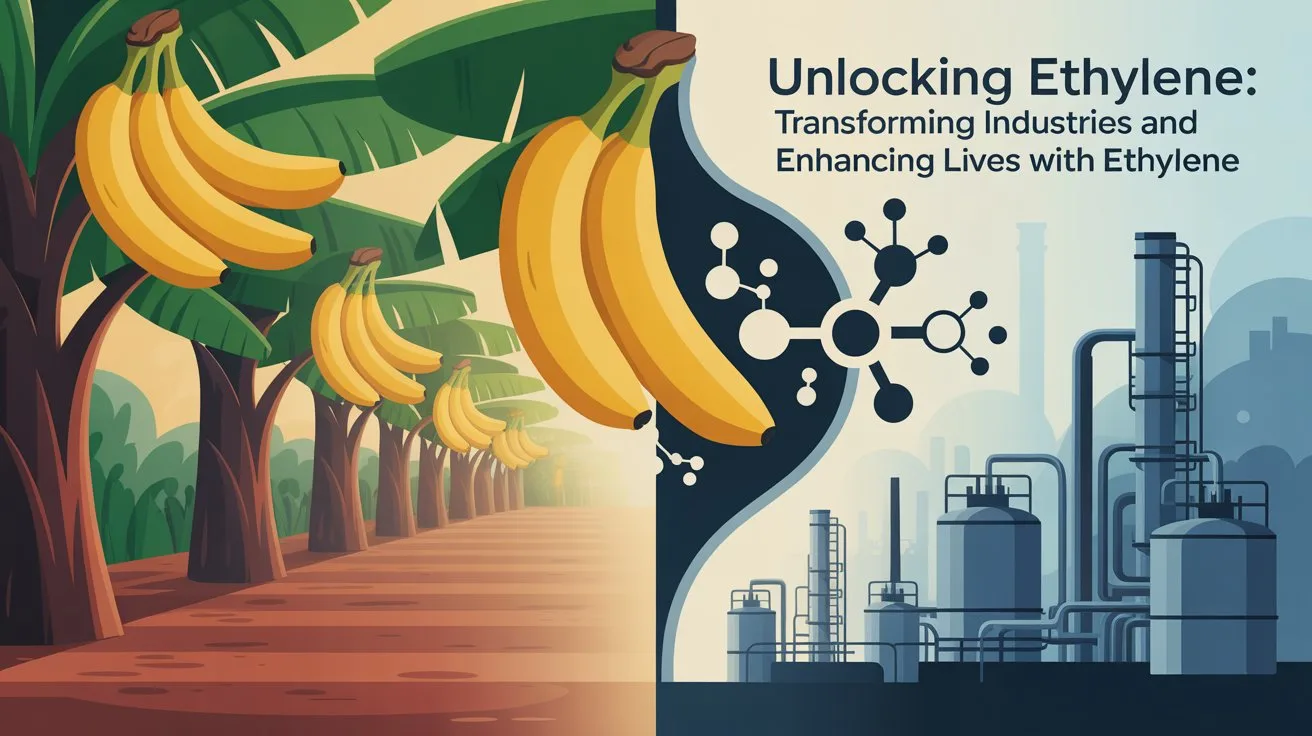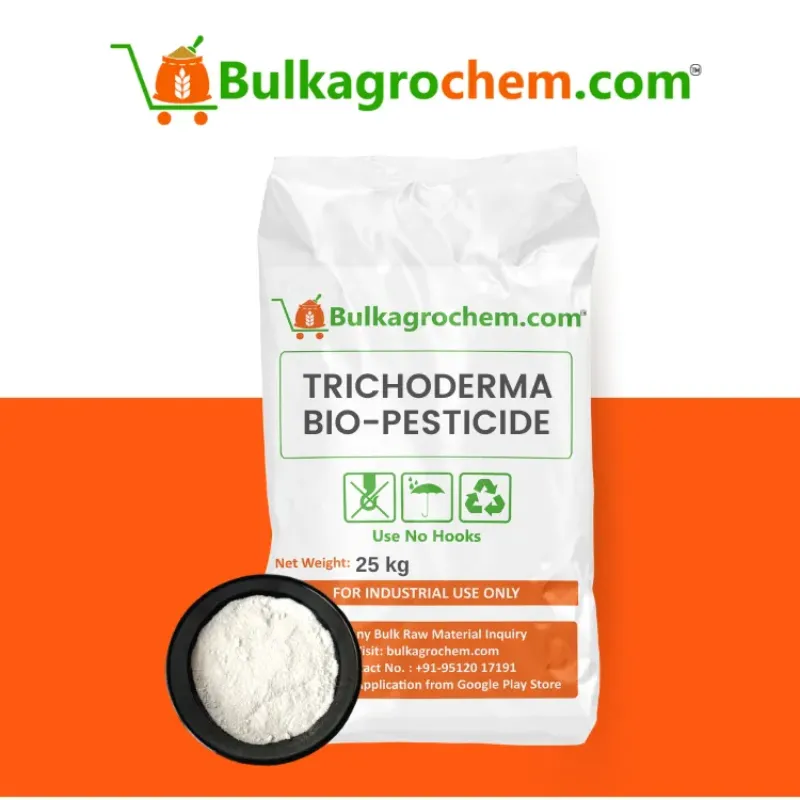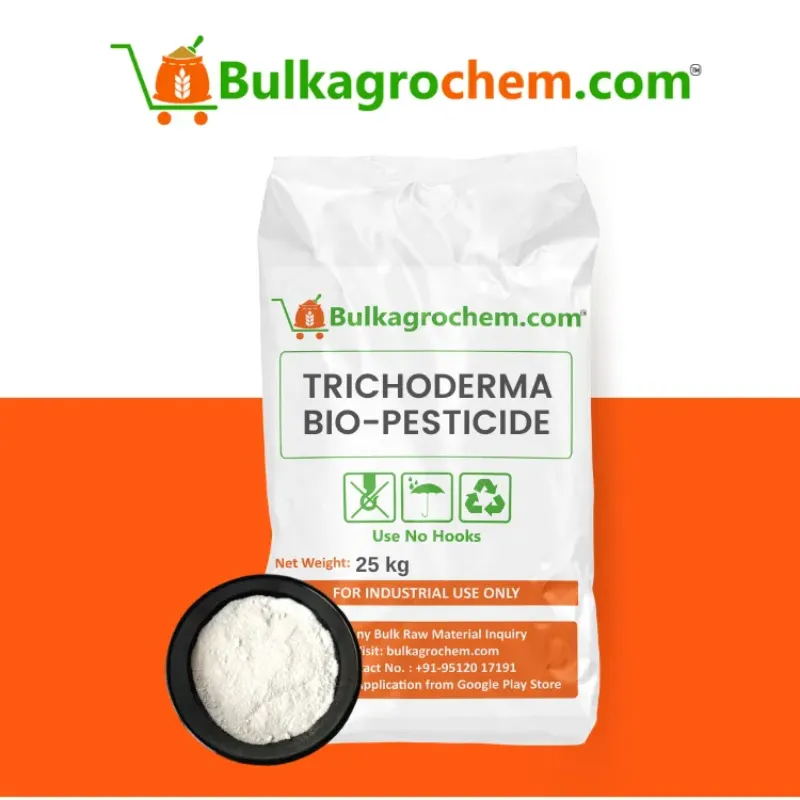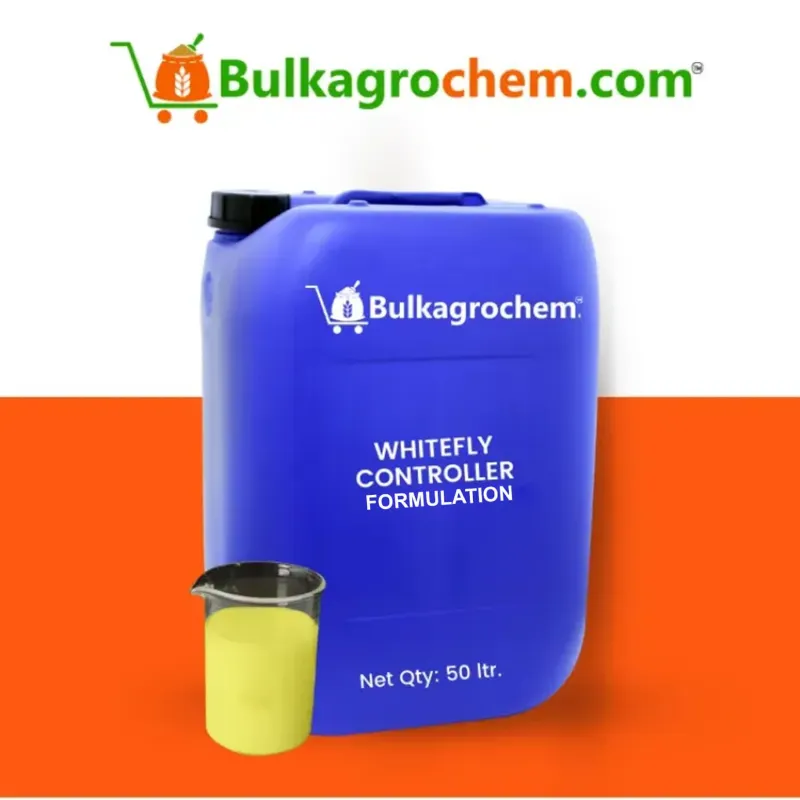Ethylene is a simple molecule gas that acts like a miracle molecule— fueling everything from plastic formation to ripening fruit.
In agricultural growing practices, using ethylene to ripen bananas guarantees the perfect color for packaging, the right sweetness, and the right texture, on tender.
Modern facilities will use artificial fruit ripening through ethylene chambers or ethylene gas generators, where producers can more safely manage the timing of post-harvest, market, and customer requirements.
The use of artificial fruit ripening by ethylene will increase the market window, decrease loss, and supply consistent quality from field to global supply chain.
Introduction: Understanding Ethylene and Its Significance in Modern Industry
Ethylene is a simple hydrocarbon molecule gas that is a prime chemical that causes much of the world's production and processes. With its unique reactivity, ethylene is foundational to everything for plastics polymerization to controlled fruit maturation.
What is ethylene? Chemical properties and global production
Ethylene's formula (C₂H₄), and double‐bonded carbon system, provide ethylene's exceptional reactivity, including routes to polymerization and oxidation reactions.
- As a consequence there exists enormous global production levels of ethylene, greater than 150 million tons annually, making it the largest petrochemical in produced volume of the top 3 most manufactured petrochemicals.
Why ethylene matters: key industrial applications overview
Ethylene is employed in polyethylene plastics, ethylene oxide sterilants and biofuel precursors, thereby solidifying its position within the respective sectors.
- In agriculture, ethylene is used in banana ripening to provide consistency in harvest time.
- In hospitals, ethylene oxide is used to sterilize surgical instruments in a way that has no parallel today.
Ethylene’s versatility across agriculture, plastics, medical and energy
From artificial ripening of fruit by ethylene from ripening rooms to artificial ripening of fruits in ripening sachets, it has diverse applications.
- Plastics: Polyethylene films and bottles.
- Medical: sterilization and the manufacture of synthetic solvents.
- Energy: precursor for bio-ethanol and next gen circular fuels.
The Role of Ethylene in Agriculture: Boosting Crop Yields and Quality
Ethylene is a versatile plant growth regulator that synchronizes maturation, stress responses and post-harvest quality which is crucial in modern agriculture crop management.
Ethylene in agriculture as a plant growth regulator and ripening agent
Ethylene influences key physiological processes by:
- Stimulating fruit softening and color change at the correct harvest time
- Controlling leaf and flower senescence to balance vegetative and reproductive development
Banana ripening with ethylene for consistent flavor and texture
Controlled banana ripening with ethylene - provides assurance that each banana bunch has the same amount of sugar and peel color,
- Fumigated at 100–150 ppm in ripening rooms during 24–48 hours
- Strictly maintaining a temperature of 18–22 °C and 90–95 % humidity and taking notes during every cycle and being confident of the results.
Practices for artificial fruit ripening by ethylene in diverse crops
Aside from bananas, artificial fruit ripening with ethylene works on mangoes, tomatoes and avocados using Shut system chambers with gas generators to emit 10–20 ppm ethylene sachets or packets that emit ethylene slowly in closed storage boxes.
Crop enhancement with ethylene: uniform harvests and shelf-life
Ethylene treatments improve on-farm performance by:
- Synchronizing flowering in cotton and cereals to select a more timely harvest extending shelf-life in leafy greens as a result of low-dosage pre-storage exposure.
- These purpose-oriented ethylene applications all provide higher yields, quality and reduced post-harvest losses over a vast array of crops.
Ethylene’s Impact on the Plastic Industry: Innovation through Polyethylene Production
Polyethylene is the most widely used plastic in the world. ethylene monomer is polymerized to produce long polymer chains that transform packaging, construction and a variety of consumer goods.
Ethylene to Polyethylene: Polymerization Basics
Ethylene molecules are polymerized through catalytic reactions, either via Ziegler–Natta or metallocene catalysts such as:
- Ziegler–Natta catalysts: yield linear HDPE that have strong tensile strength.
- Metallocene catalysts: allow for very specific control over molecular weight which is in high demand in specialty films.
Types of Polyethylene and Their Applications
Advances in Sustainable Plastics Using Bio-Ethylene
Bio-ethylene, derived from renewable feedstocks, powers a new generation of eco-friendly polyethylene:
- Sugarcane-based: Sugar-to-ethylene plants cut CO₂ emissions by 70 %.
- Mixed-feedstock reactors: Blend bio and petro-ethylene for gradual decarbonization.
Pioneering Medical Advancements Using Ethylene Derivatives
Ethylene’s versatile chemistry extends into healthcare through derivatives like ethylene oxide, which revolutionizes sterilization, and ethylene glycol and ethephon, which support medical device manufacture and plant‐based pharmaceuticals.
Ethylene oxide sterilization: mechanism and safety
Ethylene oxide (EtO) is a potent alkylating agent that sterilizes heat- and moisture-sensitive medical supplies by disrupting microbial DNA and proteins.
- Mechanism: EtO gas penetrates packaging and reacts with amino and hydroxyl groups in microorganisms, irreversibly inhibiting replication.
- Process: Instruments are exposed to 450–1200 mg/L EtO at 37–63 °C and 40–80% RH for 2–4 hours, followed by a 12–48 hour aeration to remove residual gas.
- Safety: EtO is classified as carcinogenic; modern chambers use closed-loop gas recovery and scrubbing systems to protect workers and the environment.
Other medical applications: ethylene glycol, ethephon
Beyond sterilization, ethylene derivatives serve multiple roles in healthcare production:
- Ethylene Glycol: Used as a dehydrating agent in histology and cryoprotectant for vaccine and enzyme storage due to its low freezing point.
- Ethephon: An ethylene‐releasing compound employed in plant‐based pharmaceutical crops to synchronize flowering and fruit set, improving harvest predictability for medicinal botanicals.
Regulatory and environmental considerations in healthcare use
The deployment of ethylene derivatives in medical settings is tightly regulated to balance efficacy with safety and sustainability:
- Regulations: EtO sterilizers must comply with ISO 11135 standards and EPA guidelines limiting fugitive emissions to < 0.01 ppm ambient concentration.
- Environmental Impact: Closed‐system gas reclamation captures over 90% of EtO, reducing atmospheric release and worker exposure.
- Disposal: Spent EtO cartridges and glycol waste are treated as hazardous waste, necessitating neutralization and incineration under RCRA protocols.
By harnessing ethylene derivatives with rigorous controls, the medical industry achieves sterile, reliable products while minimizing health and ecological risks.
Sustainable Energy Solutions: The Role of Ethylene in Biofuel Production
Ethylene is emerging as a cornerstone molecule for renewable energy, bridging biomass conversion and advanced fuel synthesis to bolster carbon-neutral strategies.
Bio-ethylene from biomass: production routes
Bio-ethylene is generated from plant-derived feedstocks via:
- Fermentation-to-ethanol dehydration: Bioethanol, produced by fermenting sugars from corn or sugarcane, is dehydrated over alumina catalysts at 350 °C to yield >99% ethylene.
- Syngas routes: Gasifying lignocellulosic biomass produces syngas (CO + H₂), which is catalytically converted to ethylene via Fischer–Tropsch variants.
- Biological pathways: Engineered microbes expressing ethylene-forming enzymes (EFE) directly produce ethylene from simple sugars under mild conditions, offering a low-energy alternative.
Ethylene’s conversion to bioethanol and advanced fuels
Recycling ethylene back into fuels creates circular energy loops:
- Ethylene hydration: Industrial fall-back process where ethylene reacts with steam (300 °C, 5 MPa) over phosphoric acid catalysts to regenerate bio-ethanol with >95% selectivity.
- Oligomerization to bio-gasoline: Ethylene oligomerizes into C₅–C₁₀ hydrocarbons, then hydrotreated into drop-in gasoline or jet-fuel components.
- Ethylene as feedstock for bio-butadiene and bio-propylene: Chain-extension and dehydrogenation processes yield precursors for rubber and plastics, integrating energy and material cycles.
Impact on carbon footprint and energy security
Incorporating ethylene into biofuel value chains enhances sustainability:
- GHG reductions: Life Cycle analyses show 60–80% lower CO₂ emissions vs. petrol-ethylene when using sugarcane or cellulosic feedstocks.
- Energy security: Domestic bio-ethylene production reduces reliance on volatile oil markets, stabilizing fuel supply.
- Circular economy: Ethylene’s dual role as fuel intermediate and polymer building block closes material loops, minimizing waste.H2 The Future of Ethanol Production: Innovations and Market Potential
Next-generation ethanol pathways are redefining biofuel economics by leveraging ethylene feedstocks alongside traditional sugar routes—promising scalable, low-carbon outputs.
Ethylene to ethanol conversion processes and catalysts
Ethanol can be synthesized by hydrating ethylene over solid acid catalysts, offering high selectivity and continuous operation:
- Phosphoric acid on silica: Classic catalyst operating at 300–350 °C and 5 MPa, achieving >95 % ethanol yield.
- Zeolite and heteropolyacid catalysts: Emerging materials lower energy demand and improve catalyst longevity.
Market trends for ethanol from ethene vs. sugar fermentation
Integration with circular-economy and green chemistry goals
Closed-loop ethanol systems combine ethylene recycling, CO₂ capture and biomass valorization:
- CO₂ reuse: Fermentation CO₂ feeds microalgae or chemical synthesis, closing emission loops.
- Byproduct valorization: Unconverted sugars or oligomers convert to bioplastics, maximizing resource efficiency.
- Renewable energy integration: Waste heat powers dehydration reactors, reducing net energy inputs.
These synergies position ethylene-derived ethanol as a cornerstone of sustainable, circular bioeconomies.
Frequently Asked Questions (FAQs)
Q1. Can ethylene really improve crop ripening and uniformity?
Yes—controlled ethylene exposure synchronizes fruit maturation, ensuring consistent color, texture and sugar levels across the harvest.
Q2. Is bio-ethylene as sustainable as petrochemical ethylene?
Bio-ethylene produced from biomass feedstocks can reduce greenhouse gas emissions by up to 80 % compared to petrochemical sources.
Q3. How does ethylene oxide differ from ethylene in sterilization?
Ethylene oxide is a reactive alkylating agent used to sterilize medical equipment, whereas ethylene itself is not used for sterilization.
Q4. What are the safety protocols for handling ethylene in industry?
Industries use closed‐system transfer, continuous leak detection and strict ventilation controls when handling pressurized ethylene gas.
Q5. Can polyethylene made from bio-ethylene match conventional grades?
Yes—bio‐ethylene feeds into the same polymerization processes, producing bio‐PE with identical performance to traditional polyethylene.
Conclusion: Embrace the Versatility of Ethylene to Drive Progress Across Sectors
Ethylene’s unique chemistry underpins breakthroughs from field to factory, making it a linchpin for sustainable innovation.
Recap of ethylene’s multifaceted industrial and agricultural benefits
- Agriculture: Ethylene PGRs improve fruit set and banana ripening with ethylene, ensuring uniform quality and reduced waste.
- Plastics: Ethylene-to-polyethylene drives versatile packaging and durable materials, now enhanced by bio-ethylene for lower carbon footprints.
- Medical & Energy: Derivatives like ethylene oxide sterilize critical equipment, while ethylene-based biofuels and ethanol diversify renewable energy supplies.
Next steps: adopting bio-ethylene, optimizing ethylene PGR timing, leveraging derivatives
- Switch feedstocks: Incorporate sugarcane or cellulosic bio-ethylene for cleaner production.
- Fine-tune applications: Align artificial fruit ripening by ethylene schedules with crop readiness to maximize consistency.
- Expand uses: Explore emerging ethylene derivatives in advanced materials and green chemistry.
Call to action: integrate ethylene innovations today for a sustainable tomorrow
Assess your operations—from ripening rooms to polymer plants—and identify where ethylene or its derivatives can replace less-efficient processes. Start pilot trials, track impacts, and scale successful strategies to harness ethylene’s full potential for both profitability and planet.




